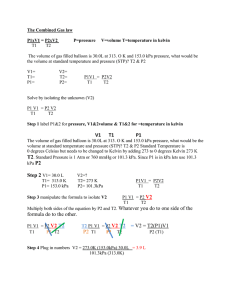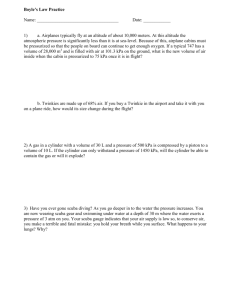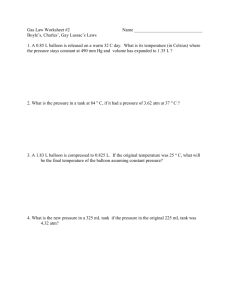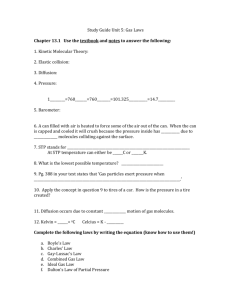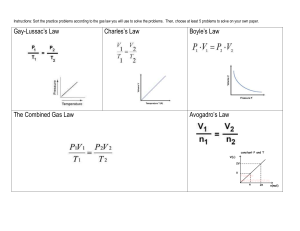Gas unit problem set
advertisement
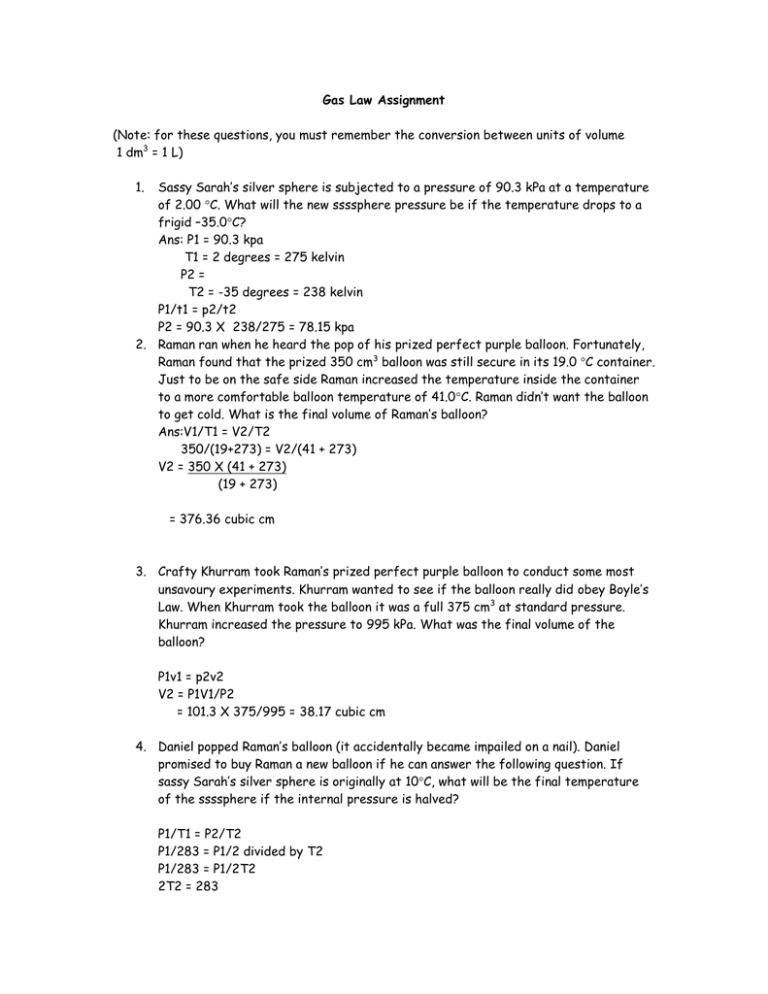
Gas Law Assignment (Note: for these questions, you must remember the conversion between units of volume 1 dm3 = 1 L) 1. Sassy Sarah’s silver sphere is subjected to a pressure of 90.3 kPa at a temperature of 2.00 C. What will the new ssssphere pressure be if the temperature drops to a frigid –35.0C? Ans: P1 = 90.3 kpa T1 = 2 degrees = 275 kelvin P2 = T2 = -35 degrees = 238 kelvin P1/t1 = p2/t2 P2 = 90.3 X 238/275 = 78.15 kpa 2. Raman ran when he heard the pop of his prized perfect purple balloon. Fortunately, Raman found that the prized 350 cm3 balloon was still secure in its 19.0 C container. Just to be on the safe side Raman increased the temperature inside the container to a more comfortable balloon temperature of 41.0C. Raman didn’t want the balloon to get cold. What is the final volume of Raman’s balloon? Ans:V1/T1 = V2/T2 350/(19+273) = V2/(41 + 273) V2 = 350 X (41 + 273) (19 + 273) = 376.36 cubic cm 3. Crafty Khurram took Raman’s prized perfect purple balloon to conduct some most unsavoury experiments. Khurram wanted to see if the balloon really did obey Boyle’s Law. When Khurram took the balloon it was a full 375 cm3 at standard pressure. Khurram increased the pressure to 995 kPa. What was the final volume of the balloon? P1v1 = p2v2 V2 = P1V1/P2 = 101.3 X 375/995 = 38.17 cubic cm 4. Daniel popped Raman’s balloon (it accidentally became impailed on a nail). Daniel promised to buy Raman a new balloon if he can answer the following question. If sassy Sarah’s silver sphere is originally at 10C, what will be the final temperature of the ssssphere if the internal pressure is halved? P1/T1 = P2/T2 P1/283 = P1/2 divided by T2 P1/283 = P1/2T2 2T2 = 283 T2 = 141.5 kelvin 5. Balloons are everywhere. A 95.0C bright blue balloon has a volume of 122cm3. What volume will the bbballon occupy at -15C? V1/T1 = V2/T2 122/368 = V2/258 V2 = 122 X 258 368 = 85.53 cubic cm 6. Claire’s compressed cylinder of awesome oxygen has a volume of 30.0 L and pressure of 1740 kPa at 27C. Claire wonders wildly about the weather. What is the temperature of oxygen if curious Claire releases it into a 500.0 L weather balloon at 100.6 kPa? Ans: V1 = 30 L, P1 = 1740 Kpa, T1 = 27 + 273 = V2 = 500 L, P2 = 100.6 kpa, T2 = P1V1/T1 = P2V2/T2 T2 = P2V2T1 P1V1 = 100.6 x 500 x 300 1740 x 30 = 289.08 k 7. Emil is impressed with Claire’s wile weather balloon. Emil emails Claire that he would like to send his own emissary into the atmosphere. Claire couriers him a stunning, shiny silver weather balloon with a volume of 500.0 L and tells him to release the ssswballoon into the atmosphere when the temperature is 16C and the pressure is 100.6 kPa. After 40 minutes, the ssswballoon has risen and is recording a temperature of -18C and a pressure of 93.5 kPa. What is the volume of Emil’s ssswballoon at this point? ANS: V1 = 500 L V2 = T1= 16 +273 = P1 = 100.6 kPA T2 = -18 +273 = V2 = T2P1V1 P2T1 V2 = 255 X 100.6kpa X 500 93.5 X 289 P2 = 93.5 KPA V2 = 474.677 Litre 8. What are the postulates (statements) of the kinetic molecular theory (look back at chapter 11). 9. What is the difference between real and ideal gases? (look at your assigned reading) 10. A real gas will condense to a liquid when the temperature is low enough. Why doesn’t this fact support the kinetic molecular theory as it applies to ideal gases? 11. Yen accurately accumulates acetylene gas at 23 C and a total ambient pressure of 98.1 kPa using the water displacement method. What is the partial pressure of dry acetylene? 12. Ricky realized that the raunchy aroma was the result of the release of 2.600 g of a volatile organic reagent which contained 0.644 g of carbon and 1.902 g of chlorine. If the compound contains only carbon, chlorine and hydrogen and occupies 730 mL at 98.7 kPa and 50C. What is the molecular formula of Ricky’s raunchy reagent? 13. Patricia postulated that she could properly compute the molar mass of gas that has a density of 1.71 g/L at a pressure of 97.0 kPa and a temperature of 26.5C. Help Patricia complete her computation. 14. Calculate the moles of air in a 250 mL beaker. Explain all of the steps you took to do this.

